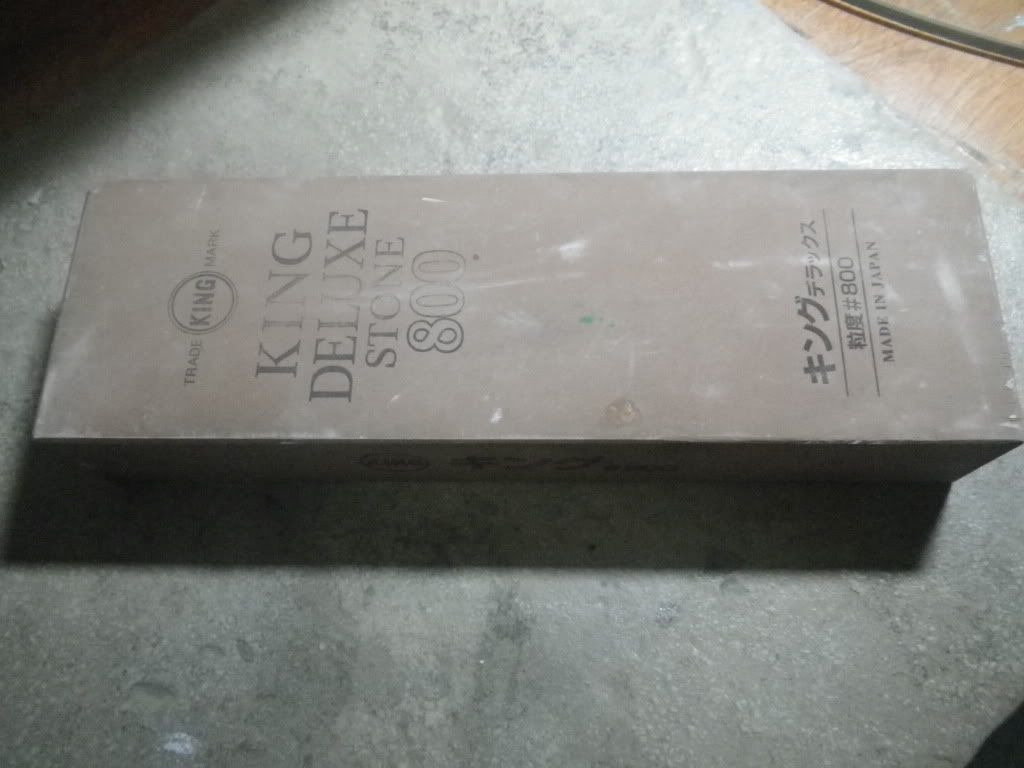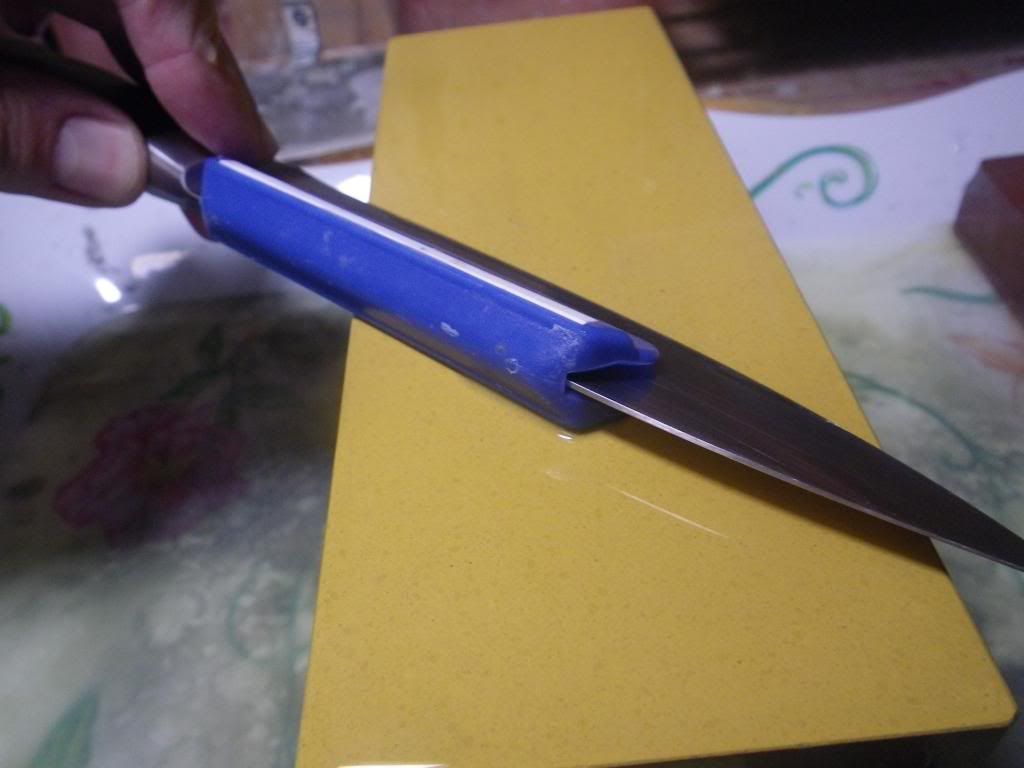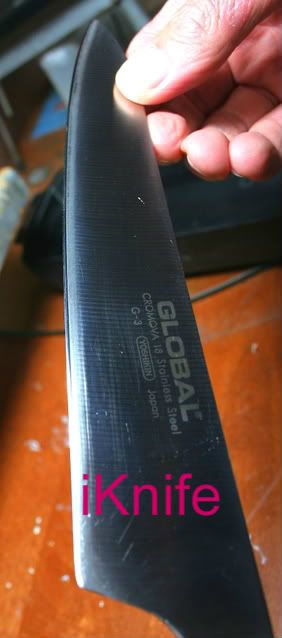Most folk own a serrated knife for cutting bread, or a smaller one for tomatoes
Serrated knives excel at cutting crusty bread, no doubt about it, when they are sharp that is.
Like any other knife purchase however, when you buy one, you need to think about how it will get sharpened. Fortunately, serrated knives tend to stay sharp for a year or so but like all other knives they get dull. However, unlike other straight edged knives, they are difficult to sharpen.
I don't know anyone else who sharpens these knives to be honest, at least not properly. You should know however that over time, over many years the serrations just wear down to little nubs and I can't sharpen it, it is time to put those ones to rest. (Unless you want me to transform it, more on that later)
I sharpen each serration individually with a series of ceramic rods and micro abrasives and a diamond cone that is fantastic for small serrations. When I have raised a burr on the flat side of the knife, I sharpen the flat side at almost zero degrees, to remove the burr.
Here is my advice on Serrated Knives. Don't buy expensive ones, get a $30.00 bread knife, or less and then just replace it when it is dull. You can easily get a year or even more out of it.
I personally don't use a serrated knife but they are really good for cutting bread.
The serrated knife performs well because the high points of the serrations (assuming the high points still exist and are not worn down) touch the material first. So a higher pressure per area is gained by these multiple points (tips of serrations) than a straight edged knife. This is all good for the first year, after that, the serrations get rounded over.
If I were to buy a serrated knife, I would look for a Victorionox, something inexpensive and just throw it away when it is dull.
However, I can transform a serrated knife into a slicer, I just remove the serrations and form a new edge and then sharpen it like any other knife. COOL eh.
I sharpening knives and my speciality is kitchen knives but I sharpen all knives such as folder, hunting and tactical knives. I don't sharpen lawn mower blades or saws, I am focused solely on knives.
Saturday 30 March 2013
Saturday 23 March 2013
Starting Out
Hi,
Ok you want to learn to sharpen and all you need is a water stone. You already have some dull knives, we all have those. The fact that you are reading this means you have the most important ingredients, the desire to learn, and an interest that may develop into a Passion.
You don't need to go out and spend a lot of money to get started, in fact, you easily get your knives sharper than new with one stone and a flattener of some type so less than $100.00
Which stone to get first you ask?
If you are just learning a coarse stone, which is in the 400-600 range can be a little dangerous. This stone will remove metal quickly, it is a wonderful stone to own, but when first learning free hand sharpening, play safe and start with something in the 800-1200 range. Now if your knife is very dull, it will take some time to raise a burr, the process of removing metal to expose that fresh edge, your target, will be slower but safer. Use this medium grit range to get comfortable with your angle and start on a PRACTICE knife. Don't take out your favourite knife and start.
Ideally, you will want 3 stone, coarse, medium and fine, 400, 1000, 4000 for example or even up to 2,000 grit is perfect for just about all your needs in the kitchen.
So you could go to Lee Valley and pick up a King 800 or King 1200 for about $30.00 and start your journey.
Next I will explain how to keep those stones Flat.
Thank you for being here.
Ok you want to learn to sharpen and all you need is a water stone. You already have some dull knives, we all have those. The fact that you are reading this means you have the most important ingredients, the desire to learn, and an interest that may develop into a Passion.
You don't need to go out and spend a lot of money to get started, in fact, you easily get your knives sharper than new with one stone and a flattener of some type so less than $100.00
Which stone to get first you ask?
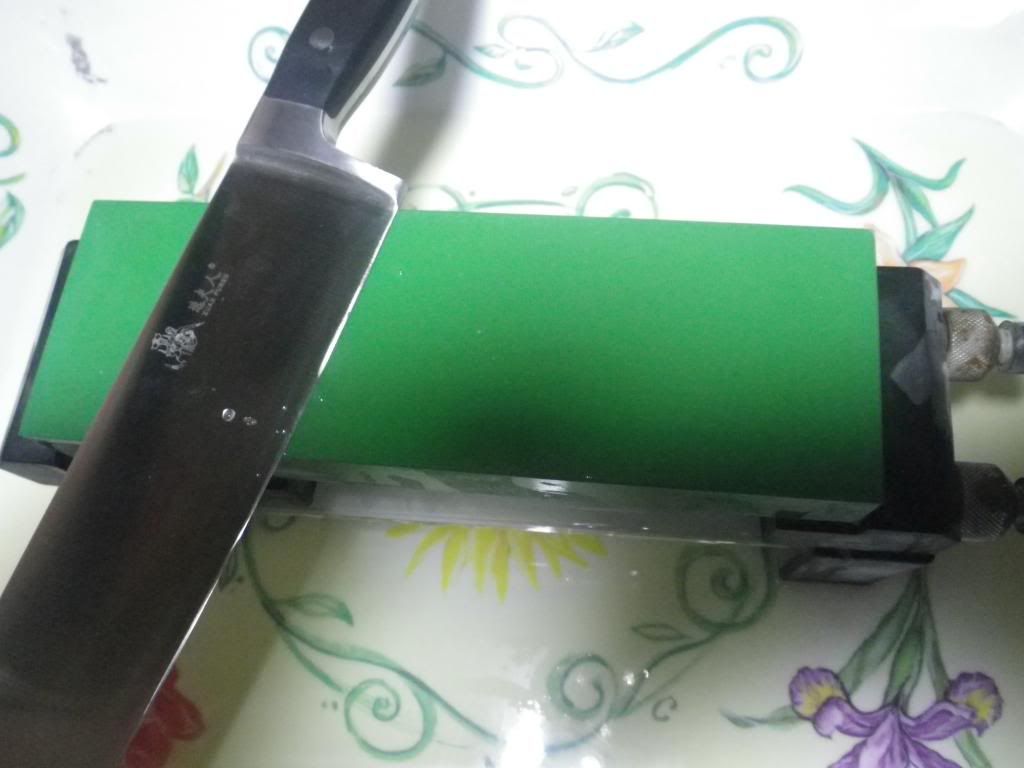 |
| 1, 000 Grit Japanese Water Stone |
Ideally, you will want 3 stone, coarse, medium and fine, 400, 1000, 4000 for example or even up to 2,000 grit is perfect for just about all your needs in the kitchen.
So you could go to Lee Valley and pick up a King 800 or King 1200 for about $30.00 and start your journey.
Next I will explain how to keep those stones Flat.
Thank you for being here.
Thursday 7 March 2013
Traditional Japanese Knives
Tuesday 5 March 2013
ANGLE - I'm afraid
I think the most common fear of sharpening is that the knife will be permanently ruined because you did not sharpen it at the exact same angle that the factory set.
Well here is something to think about:
What are your options?
1. Try sharpening it anyway and do your best to keep a steady angle, regardless of the factory angle; or
2. Just keep using it dull, that way it won't be ruined.
Do not concern yourself too much about the angle. There is only one thing to be concerned about when learning to sharpen a knife by freehand. CONSISTENCY.
So you hold the knife at an angle that you THINK is similar to the factory set angle which is likely about 20 degrees. As long as you can hold that angle and keep it steady as you sharpen and as long as you are hitting the edge of the knife you will succeed. It doesn't matter if the angle you are using is 22 degrees of 18, as long as it isn't 14, 22, 18, 25 and so as you move the knife.
I've already explained the sharpie trick so this will guide you but again, do not be overly concerned about keeping the same angle. You won't notice.
So assume that you Wusthof or Henckels is new or never been sharpened beyond the factory and the angle on it now is 22 degrees. So you want to match that 22 degrees on either side of the knife. So a 44 degree included angle. Just do your best to hold it, an inch will give you a 20 degree angle on an 8inch chef knife. It's your knife, sharpen it at an angle that seems natural and feels comfortable. Over time, muscle memory will kick in and you will automatically hold the knife at that same angle. BIG DEAL if it is a degree or even 4 degrees off.
I have purposely changed the angle on many knives, and every one of them still cut. Who the heck can pick up a knife, and say, ok that was sharpened at the factory at 19 degrees. If you read the GLOBAL Knife sharpening instructions online it will say to hold the knife between 10-15 degrees. IT does not say, "hold the knife at 15 degrees exactly or your warranty is void"
Global Sharpening Instructions
Here is where I hold the knife:
So what angle is it.......I don't know, probably 19 degrees. The point here is that I know that I am hitting the edge, removing fatigued metal and sharpening this knife. I don't care if it is at 19 or 21 degrees and neither does the owner.
Now you can purchase a device like this one that will set the angle for you:
However, I have never used this because it just gets in the way but it is handy for showing what a 19 degree angle looks like.
The whole point of this is to talk you out of the notion that the wrong angle will ruin the knife. That is completely untrue unless you hold the knife at 90 degrees or something.
This is easy folks:
It's a leap of faith......jump in.
Well here is something to think about:
What are your options?
1. Try sharpening it anyway and do your best to keep a steady angle, regardless of the factory angle; or
2. Just keep using it dull, that way it won't be ruined.
Do not concern yourself too much about the angle. There is only one thing to be concerned about when learning to sharpen a knife by freehand. CONSISTENCY.
So you hold the knife at an angle that you THINK is similar to the factory set angle which is likely about 20 degrees. As long as you can hold that angle and keep it steady as you sharpen and as long as you are hitting the edge of the knife you will succeed. It doesn't matter if the angle you are using is 22 degrees of 18, as long as it isn't 14, 22, 18, 25 and so as you move the knife.
I've already explained the sharpie trick so this will guide you but again, do not be overly concerned about keeping the same angle. You won't notice.
So assume that you Wusthof or Henckels is new or never been sharpened beyond the factory and the angle on it now is 22 degrees. So you want to match that 22 degrees on either side of the knife. So a 44 degree included angle. Just do your best to hold it, an inch will give you a 20 degree angle on an 8inch chef knife. It's your knife, sharpen it at an angle that seems natural and feels comfortable. Over time, muscle memory will kick in and you will automatically hold the knife at that same angle. BIG DEAL if it is a degree or even 4 degrees off.
I have purposely changed the angle on many knives, and every one of them still cut. Who the heck can pick up a knife, and say, ok that was sharpened at the factory at 19 degrees. If you read the GLOBAL Knife sharpening instructions online it will say to hold the knife between 10-15 degrees. IT does not say, "hold the knife at 15 degrees exactly or your warranty is void"
Global Sharpening Instructions
Here is where I hold the knife:
So what angle is it.......I don't know, probably 19 degrees. The point here is that I know that I am hitting the edge, removing fatigued metal and sharpening this knife. I don't care if it is at 19 or 21 degrees and neither does the owner.
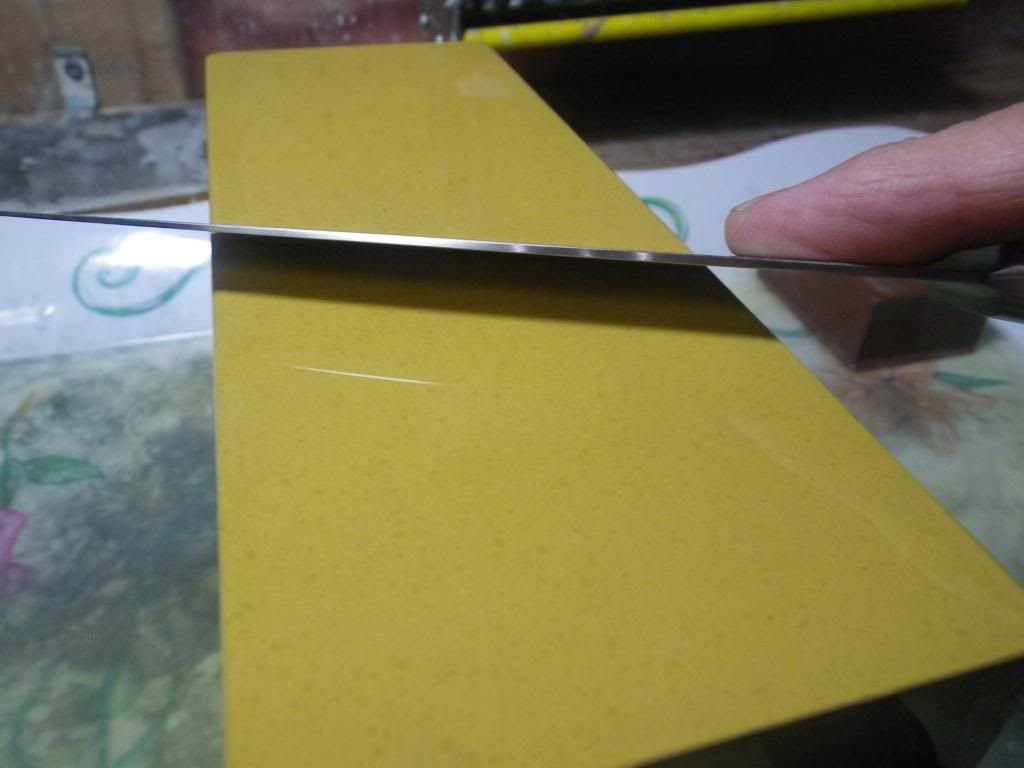 |
| My Angle |
However, I have never used this because it just gets in the way but it is handy for showing what a 19 degree angle looks like.
The whole point of this is to talk you out of the notion that the wrong angle will ruin the knife. That is completely untrue unless you hold the knife at 90 degrees or something.
This is easy folks:
It's a leap of faith......jump in.
I want to learn to sharpen my own knives
Congratulations, sharpening knives by hand is THE most rewarding experience that I have ever encountered.
It is relaxing, inexpensive and really not all that difficult with patience, practice and then some more of each.
The coolest thing about knife sharpening is that you can make your knives sharper than when you bought them, right at home. Once you get the hang of it, you'll be sharpening every knife you can get your hands on.
This is what you need:
1. A knife - it's dull.........even if you just took it out of the box it could get sharper, within a month it will definitely need to be sharpened. (MAC knives are one of the sharpest OOTB (Out of the box) that are available, these will be fine for a while)
2. Japanese water stones (oil stones work yes, I use and recommend water stones). You NEED one but you should have two or three. If going for two which is fine, you need a medium stone, about 800-1200 grit and a fine stone, 2000 and up. A coarse stone removes metal fast (500 grit and below) so you need to be careful with these when learning.
3. Watch the Videos by Jon Broida that I have linked earlier, or just go to Japanese Knife Imports and select his media links. His are the best sharpening videos that I have seen. I have shared dozens of emails with Jon and I trust him completely. I sharpen knives as described in the videos and it works. or, go to YouTube and search for KORIN knife sharpening, another excellent demonstration.
4. If I was just starting and I was on a budget I would go to Lee Valley and pick up an #800 grit King Stone and a #2000 grit Bester Stone.
5. With just these two stones, you can take your dull knives to the point where you will not believe is possible. If you want to further refine the edge, get a #4000 grit Imanishi stone too and the edge and polish that comes from that will blow you away.
When you are ready to start, if you have any questions just send me an email at sharpknives@me.com.
I can walk you through it, if you want to come and visit me for a lesson, (best option) that is also very possible. Private lessons are available at very reasonable rates, cheaper than most gadgets.
I can help you, you can toss away any gadgets that you own.......they are gadgets and you don't need them, they are nothing more than Frustration Builders, you are fooling yourself if you think they work. (Ask me how I know this :) )
I'm there for you, if you want to learn you know how to get hold of me. 902 225 0579
It is relaxing, inexpensive and really not all that difficult with patience, practice and then some more of each.
The coolest thing about knife sharpening is that you can make your knives sharper than when you bought them, right at home. Once you get the hang of it, you'll be sharpening every knife you can get your hands on.
This is what you need:
1. A knife - it's dull.........even if you just took it out of the box it could get sharper, within a month it will definitely need to be sharpened. (MAC knives are one of the sharpest OOTB (Out of the box) that are available, these will be fine for a while)
2. Japanese water stones (oil stones work yes, I use and recommend water stones). You NEED one but you should have two or three. If going for two which is fine, you need a medium stone, about 800-1200 grit and a fine stone, 2000 and up. A coarse stone removes metal fast (500 grit and below) so you need to be careful with these when learning.
3. Watch the Videos by Jon Broida that I have linked earlier, or just go to Japanese Knife Imports and select his media links. His are the best sharpening videos that I have seen. I have shared dozens of emails with Jon and I trust him completely. I sharpen knives as described in the videos and it works. or, go to YouTube and search for KORIN knife sharpening, another excellent demonstration.
4. If I was just starting and I was on a budget I would go to Lee Valley and pick up an #800 grit King Stone and a #2000 grit Bester Stone.
5. With just these two stones, you can take your dull knives to the point where you will not believe is possible. If you want to further refine the edge, get a #4000 grit Imanishi stone too and the edge and polish that comes from that will blow you away.
When you are ready to start, if you have any questions just send me an email at sharpknives@me.com.
I can walk you through it, if you want to come and visit me for a lesson, (best option) that is also very possible. Private lessons are available at very reasonable rates, cheaper than most gadgets.
I can help you, you can toss away any gadgets that you own.......they are gadgets and you don't need them, they are nothing more than Frustration Builders, you are fooling yourself if you think they work. (Ask me how I know this :) )
I'm there for you, if you want to learn you know how to get hold of me. 902 225 0579
Subscribe to:
Posts (Atom)

